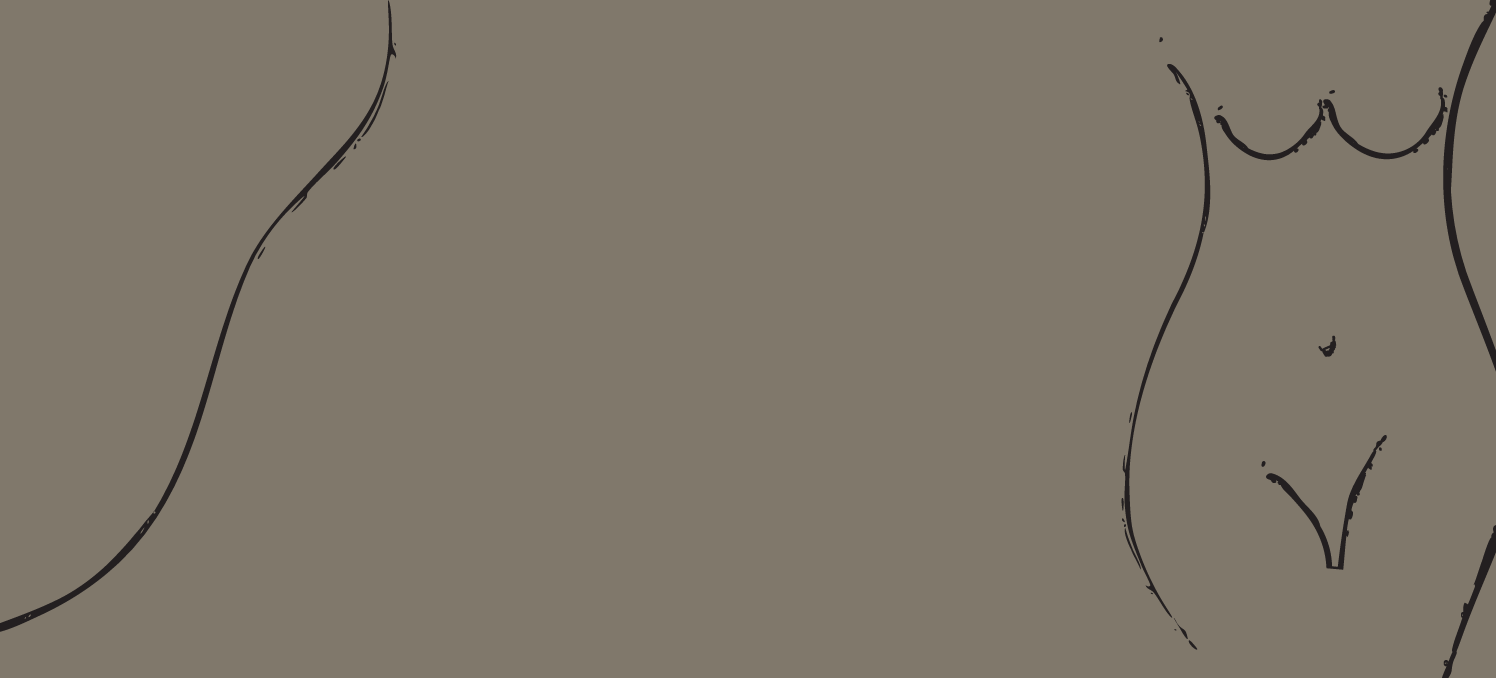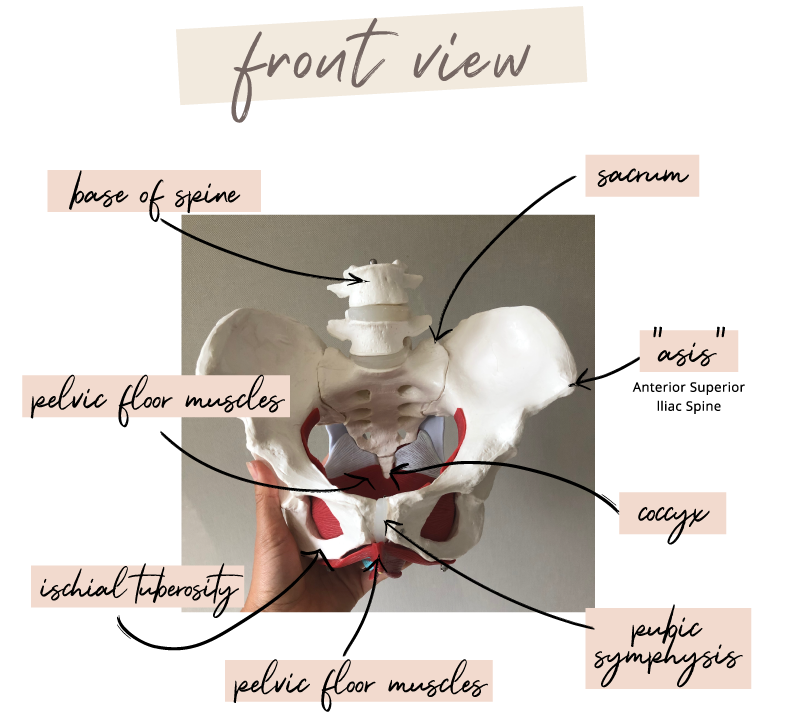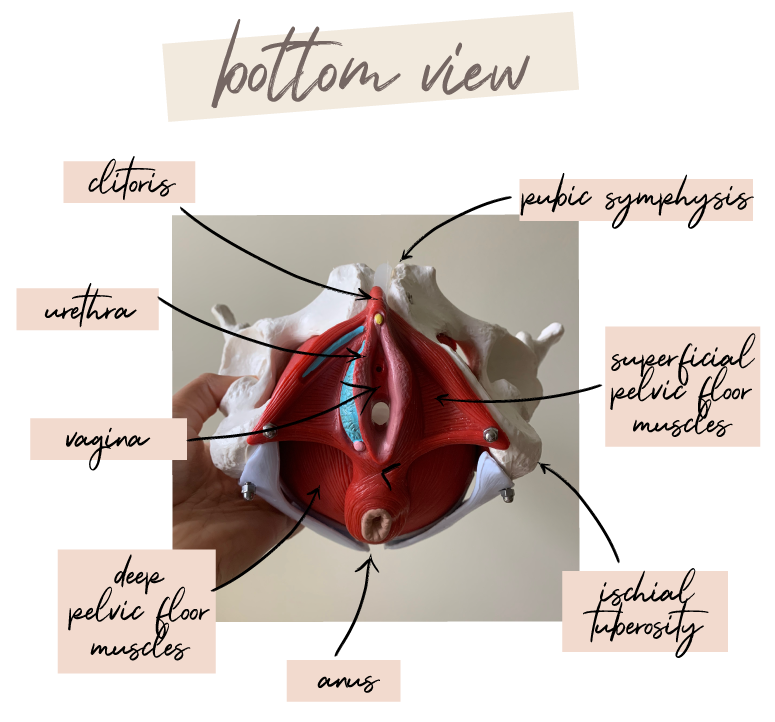
WHAT IS A PELVIC FLOOR?
The pelvic floor is a buzz word at the moment, but most people have no concept of what it actually is!
First of all, it’s a muscle (just like your bicep in your arm or calf in your leg) and it sits like a trampoline at the base of your pelvis. It’s actually a sheet of multiple muscles, that together form somewhat of a “sling”. If you take your hands and feel the hard bone low down at the front of your tummy, that’s your pubic symphysis. Then at your back, follow your spine all the way down to the tip of your tailbone, that’s your coccyx! Now, in sitting, move from side to side and feel the hard bones underneath each of your bottom cheeks, these are your ischial tuberosities. If we think of these 4 spots as the edges of a diamond, your pelvic floor virtually slings between each corner of this diamond.
On top of your pelvic floor sits your bladder at the front, your uterus, then your bowel/rectum at the back. These are referred to collectively as your pelvic organs (because they are organs that reside within the pelvis). Your pelvic floor plays a role in holding these organs up against gravity.
Our bladder, uterus and bowel exit the body through spaces in the pelvic floor. Our bladder exits via the urethra, our uterus through the vaginal opening and our bowel through the rectum.
Each of these exits opens and closes or becomes smaller or larger through the action of the pelvic floor.
WHEN FUNCTIONING CORRECTLY, THE PELVIC FLOOR PLAYS A ROLE IN:
- Holding urine when we need to wee but aren’t near a toilet
- Holding urine when we do something that puts a lot of stress on our bladder (such as coughing, laughing or jumping)
- Holding wind or poo when we aren’t near the toilet
- Increasing sexual arousal and reaching orgasm
- Maintaining the pelvic organs high up within the pelvic cavity
- Holding a tampon in
- Allowing us to do a poo with ease
- Keeping our back and hips strong and pain free
- Good “core” stability
HOW DO I KNOW IF MY PELVIC FLOOR HAS A PROBLEM?

Just like any other muscle in the body, the pelvic floor can be “on” or “off”, tight or stretched, weak or strong. Some individuals can coordinate its use well and smoothly and others may struggle to turn it on at all. And all of these factors will affect how the muscle does its job.
The first and most obvious way this might happen is if the muscle becomes torn or cut. This usually occurs during childbirth but can happen with any other type of acute traumatic injury such as a car accident or through sexual trauma. The nerve pathways that sends a message to the muscle to turn on/off can also be damaged. This might occur through childbirth or other physical trauma at the level of the pelvic floor. Or it might occur higher up in the case of abdominal surgery, spinal cord injury or brain injury.
Some less obvious things that can lead to a poorly or non functioning pelvic floor:
- High physical stress (being overweight, chronic coughing/sneezing)
- Overuse (gymnasts, weight lifting, athletes)
- High emotional stress (anxiety, depression, overthinking)
- Tight hip muscles or pain/injury at the level of the back or hips
HOW HEALTHY IS YOUR PELVIC FLOOR?
Take the 5 minute quiz below to quickly find out!
Awareness
HOW TO FIND YOUR PELVIC FLOOR
The key to a strong healthy pelvic floor is AWARENESS. It is easy for us to exercise our calf muscle because we can see it and it is obvious when it is active/at rest. The difficulty with the pelvic floor is that you cannot see it. So the first step is to tap into our internal awareness and “feedback”. This starts with the brain.
Note that you cannot turn on a muscle that is already on, so that’s why the first step always starts with relaxation. Often women who have had trouble with working their pelvic floor in the past actually have tight and overactive pelvic floors. It is well known in the medical field that almost half of women when given a simple instruction to squeeze their pelvic floors, actually perform the exercise incorrectly. So that’s why taking the time now to perfect your awareness is crucial to the success of your overall pelvic floor health.
Start by sitting with your back supported and tummy muscles relaxed, or lying down on your back with your knees bent and feet flat on the floor. Close your eyes and take your attention down to your pelvis, pay attention to sensations like blood flow, temperature, the feeling of your clothes against your skin. Now target your attention even more to the entrance to your vagina. For the sake of this awareness activity, picture the muscles like a circle (similar to those around your mouth). See if you can gently squeeze them by picturing these muscles plucking a tissue or picking up a blueberry. The muscle has two actions, you should feel the muscles gently tighten as well as lift towards your belly button. When you relax you should feel the muscles “drop” a little and relax outward. Be sure to check out this blog post where we run through a 5 step process to locate and switch on your pelvic floor.
If you are still having trouble. Take a rest, and come back to this on a different day. After all, this is an exercise and it takes practice. Be patient with yourself and don’t beat yourself up if you don’t get it first go. You could also book in to see a womens health physiotherapist. We are able to do an internal assessment (which is not as scary as it sounds) to assist you in locating and working your pelvic floor. And we can give you feedback straight away to let you know if you are squeezing/working the right muscles in the correct way.




